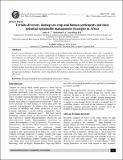Termite diversity, damage on crop and human settlements and their potential sustainable management strategies in Africa
Abstract
Termites are problematic insects due to their threat in agricultural fields and human settlements. They cause a significant loss to food and cash crops, wooden components in buildings and trees of economic importance, especially in warm environments of subtropical and tropical regions. For a long time, termite attack has been controlled using different chemical methods, though they cause human health and environmental problems. This review has been focused on termite diversity, damage caused by termites in crop plants and other infrastructures as well as three eco-friendly alternative methods such as insecticidal plants, biological method and cultural control. Methods discussed under cultural approach include animal by-products, dead animals, meat and sugarcane husks, wood ashes and intercropping system. For biological method the focus is on nematode, bacterial and fungal application while the insecticidal plants highlighted on the potential of Cupressus lusitanica, Tephrosia vogelii,Eucalpytus dalrympleana, Lantana camara and Azadirachta indica in the controlindica in the control of termites.
URI
https://www.isca.me/AGRI_FORESTRY/Archive/v7/i1/5.ISCA-RJAFS-2018-034.pdfhttps://dspace.nm-aist.ac.tz/handle/20.500.12479/2484

